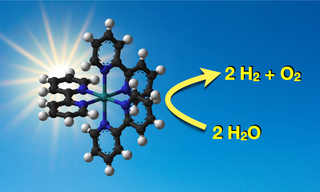Solid-State Illumination for Solar Fuel Cell Development
In contrast to photovoltaic technologies, which seek to generate electricity directly from sunlight, the goal of artificial photosynthesis is to convert sunlight into stored chemical energy. This can be accomplished by photoelectrochemical splitting of water into hydrogen fuel and oxygen in dye-sensitized photoelectrosynthesis cells (DSPEC) (1) . Extensive research efforts to improve DSPEC efficiency are currently underway. For example, researchers in Dr. Thomas Meyer’s laboratory at the University of North Carolina at Chapel Hill have described a second-generation DSPEC that achieves greatly enhanced visible-light–driven water splitting efficiencies. Performance evaluation was carried out using 445 nm light output from a SPECTRA Light Engine (2). Lumencor’s solid state Light Engines provide the precise illumination control capabilities required for quantitative determination of DSPEC efficiency. Light Engine attributes of particular importance in these applications include microsecond wavelength switch time, feedback-stabilized linear intensity control and linear intensity control.

- Mar 15, 2023

- (1) T Kawawaki, M Kawachi, Y Negishi et al. Development and functionalization of visible light-driven water splitting photocatalysts. Nanomaterials (2022) 12:344(opens in new window)
- (2) L Alibabaei, BD Sherman, TJ Meyer et al. Visible photoelectrochemical water splitting into H2 and O2 in a dye-sensitized photoelectrosynthesis cell. Proc Natl Acad Sci USA (2015) 112:5899–5902(opens in new window)


